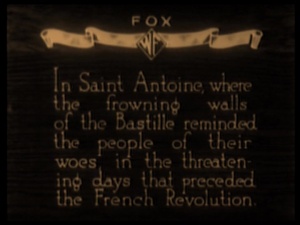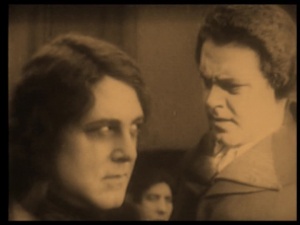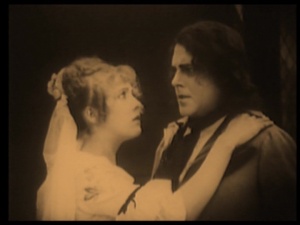It was the best of times… to make a Dickens adaptation! Movies were getting ever bigger in the 1910s and Fox decided to stage its own version of this literary classic about the French Revolution and far, far better things.
Director Frank Lloyd is sometimes damned by faint praise; “unpretentious” and “technically skilled” don’t exactly make him sound like a master of his craft. I feel that’s a bit unfair as he was one of the best costume drama directors in the business during the silent and classic film era. If you think that’s easy, just take a look at the number of directors swallowed whole by gilded sets, petticoats and plumes.

Lloyd’s great strength was understatement. He didn’t meander on loving shots of elaborate sets, sailing ships and casts of thousands. He didn’t throw in personal flourishes that would distract the audience. He was all about telling the story and bless him for it. (I’m a horrible philistine and the auteur theory makes me roll my eyes. I am an advocate for the elegance of an invisible directorial hand.)
You may have seen the 1924 version of The Sea Hawk (if you haven’t, see it at once, it’s splendid) and most classic film buffs can do a plausible impression of Charles Laughton in 1935’s Mutiny on the Bounty. Lloyd was at his best with nautical stuff, no doubt about it, but he did just fine with powdered wigs and frock coats when the occasion called for it.

The occasion called when Lloyd was selected to direct Fox’s fancy new version of A Tale of Two Cities. He had only been directing for three years and had been making features for one, so this was quite the opportunity and Lloyd recognized it. Directors had to fight tooth and nail to be assigned “big” pictures and Frank Lloyd meant to make to most of his shot at the majors.
The story is, of course, based on the novel by Charles Dickens. It is, of course, long and crammed to the gills with characters and incidents and includes one of the most legendary opening lines in the history of English literature:

Oh, they left that out? Um, okay.
Anyway, the story focuses on Charles Darnay (William Farnum), a French nobleman living in England. His family back in France is pretty much the Revolution started as they ravish peasants, imprison their enemies and run over children with their carriages. Darnay has renounced them and is romancing Lucie Manette (Jewel Carmen), whose father has been imprisoned in the Bastille.
When Darnay runs into a spot of legal trouble, he is introduced to Sydney Carton (Farnum again). Carton uses his resemblance to Darnay to resolve his legal problems and then just sort of hangs around because he is in love with Lucie. Naturally, things go belly-up in France, Charles finds himself threatened with the guillotine thanks to Madame Defarge (Rosita Marstini), a vengeful figure from everybody’s past who encodes her enemies list into her knitting.

Well, it’s up to Carton to once again use his resemblance to Darnay to save the day, this time at a far greater cost to himself. And his final words are among the most legendary in the history of English literature:

Okay, so we’re one for two, movie.
There’s a lot more to it, of course, but I think most people will have at least a passing familiarity with the story or at least the Ronald Colman movie.

I’ve been a French Revolution buff since the fifth grade, when my teacher showed the class all her research on the topic. (She had just made a trip to Paris for further study.) We were all decidedly on the side of the sans-culottes, especially after we saw a comparison of the aristocratic diet and lifestyle vs. that of the peasants. We also started to read an abridged edition of A Tale of Two Cities but then my family moved and I never got to finish the book with the rest of my class, which irritated me greatly. (“Mom, I’m trying to become a revolutionary here!”)
I had to complete the book on my own (unabridged, thank you very much) and I continued to be interested in the general era. (I remain wary of the aristocracy, despite the best efforts of Baroness Orczy.) So, obviously, this movie is very much in my wheelhouse.

Without a doubt, the star of this film is the gigantic replica of Paris and the Bastille. Frank Lloyd stages a storming and he does the revolutionaries proud. We get smashed doors, scaled walls and officers thrown into the moat. Lloyd is neither timid of his sets, nor does he feel the need to send us on a guided tour. Instead, he approaches them with confidence and never loses the drama and action of the scene. Applause all around!
In interviews given at the time of the film’s release, Frank Lloyd comes across as humble and sincere, two qualities most assuredly not associated with film directors. He felt that it was his duty to place himself below Dickens and to try to make a film that interpreted the great author’s work as faithfully as possible. Of course, needless to say, any motion picture adaptation of Dickens will require nips and tucks in order to fit the famously verbose author’s stories into the length of a feature.

I won’t be doing a full “did it follow the book?” review because I simply haven’t been in a Dickens re-read mode but there are certain rules that hold true for most of his works. The good girl love interests are boring (Bella Wilfer for the win!), the best characters are the craziest and they often die, you can judge a character by his or her name, etc. I do confess that I prefer the marginally less-famous works of Dickens (Our Mutual Friend, Nicholas Nickleby) to the Big Hits (Oliver Twist, Great Expectations, A Tale of Two Cities).
As I said, trimming was needed but the film gets the general plot of the book, doesn’t add much frippery and keeps the downer ending. (No actor would ever allow his “Far, far better” speech to be taken away!) All in all, a successful adaptation that should help you cheat in English class.

And now for the cast. It has been decreed that every generation of American moviegoers must have some handsome brothers to swoon over and in the 1910s, that role was filled by the Farnums, William and Dustin. (The third brother, Marshall, passed away in 1917.) Both brothers specialized in westerns but were more than ready to don powdered wigs when the occasion called for it.
William, our Farnum for the evening, is more interesting as Sydney than he is as Charles but that’s not really surprising. It’s far more amusing to play a curmudgeon than a noble loverboy. To be honest, Sydney is the only character in the film who registers on a human level for me.


I do think that the film missed an opportunity in having William Farnum play both roles. He and his brother Dustin had an unusually strong family resemblance and it would have been far more interesting to cast the brothers as the leads. I understand that actors love dual roles but Charles and Sydney weren’t twins, just doppelgangers and it might have given Charles more life if whoever played him was focused on him alone.
Double exposure was a common trick in movies in 1917 but the double William Farnum scenes are rather well-done and Farnum was properly praised for declining to use globs of makeup to differentiate Darnay from Carton, so the casting was not a total loss.

Jewel Carmen is given more to do here than giggle or scream (as she was obliged to do in Flirting with Fate and The Bat) but that doesn’t make Lucie a particularly interesting character. Give me Madame Defarge or Miss Pross, Lucie’s protective nurse, any day of the week.
Critical response was universally positive, something that seemed to take the critics themselves by surprise. Photoplay’s Julian Johnson stated accurately, if a bit brutally, that the picture’s success could hardly have been predicted. “As big plays most often do, it came surprisingly as a shot from a dark doorway. Lloyd was assuredly of no special eminence; William Farnum has achieved celebrity and a fortune not as an actor of characters but as a purveyor of William Farnum; Fox is an industrious wholesaler of teary melodramas and vampires.”

Owch! Though Johnson does make up for all of this by gushing over performances and production values.
Motography’s George W. Graves stated that the tension was so strong that he experienced “post-movie play relief” once the suspense was over. Peter Milne, writing for Motion Picture News, described Lloyd’s mob scenes as masterly and praised all the performances, particularly Farnum’s Sydney Carton. In short, Fox had a critical darling on its hands.

I have to confess that I was less enthused about the picture. The cinematography, mob scenes and atmosphere are all excellent but a large portion of the film takes place in England and Lloyd seems unable to bring the same zip to these scenes that he did to the French ones. Admittedly, this is asking a lot because English drawing rooms and courts, while most fascinating in BBC dramas, are never going to compete with France on the brink of revolt. Still, the change in tone does induce a bit of whiplash.
The characters are also a bit remote and “costume film” if you take my meaning. There is much noble posing and fainting and whatnot but I was looking for more of the human factor, which Lloyd would find with more directing experience. A more mature Lloyd would knock historical fact and fiction out of the park in The Sea Hawk and Mutiny on the Bounty.

A Tale of Two Cities is a gorgeous epic that suffers from a bit of remoteness but still manages to tell a dynamic story. It’s not exactly the masterpiece that 1917 critics declared it to be but it’s quite a decent adaptation. English lit nerds and French Revolution buffs should find plenty to love.
Where can I see it?
I have the version released on DVD by Grapevine. It also includes the 1911 version of the film with Maurice Costello as Sydney and Leo Delaney as Darnay.
***
Like what you’re reading? Please consider sponsoring me on Patreon. All patrons will get early previews of upcoming features, exclusive polls and other goodies.

Thanks for bringing this to our attention. ‘tis strange to think now,how difficult it was, back in the day, to make money from costume drama. They were an expensive risk. The majority of audiences wanted to see themselves on-screen, or their stars in ‘up to the minute clothes’. This one seems to be a reasonably well-crafted film, aided by the scenes of violence then in vogue in the cheap seats. By the way, England was not always full of drawing rooms and plush carpets. There were numerous rebellions, but only one guy had his head snicked off!
Costume dramas were reasonably popular during this period because, as the reviews show, they helped build a studio’s reputation as being more than a house of schlock and vampires. But, of course, they really built things back then, so the budgets always made things risky.
Oh yes, I am quite aware that English society was stratified and they had wars and uprisings aplenty but in THIS film, with THESE characters, we get English banks and English gardens and English drawing rooms but not much of the local color that makes the Paris scenes so interesting. It’s all incredibly polite and thus pales in comparison when Parisians have psychotic knitters running the streets.
Apologies if I appeared to be casting aspersions about your knowledge of history. This was not my intention. My own comments on English history were just a bit of added silliness.
No worries at all! The internet can make it quite challenging to put across a joke, I know I’ve had issues more than once. 🙂
First off, I love this review, I read every word.
I love A Tale of Two Cities!!! It is one of my favorite books!! Yes, Sydney Carton is my favorite character, he might have bad habits and what not, but he is a hero. It’s a pity they used the same actor, it would have been much better with the brothers!
Miss Pross is my favorite female character, she loves people and takes care of them. Did this movie include the part about Madame Defarge and her? I did not see it coming in the book.
I usually get really mad if the movie doesn’t follow the book exactly, but I’m usually okay with it in the early movies up to the 40s just because they were still getting the hang of making movies!
I have never seen anything by this director (It’s bad, I know. But, I haven’t had the chance!) but it sounds like he did a very good job. But, I don’t like the whiplash effect, it gives me a headache.
I really enjoyed all the captions you put, I was laughing out loud for the knitting one.
Once again, I enjoyed reading this review!
Thank you so much!
If you mean the Pross vs. Defarge smackdown, oh yes indeed!
Keeping in mind that I didn’t do a reread before watching and I am a long, long way from fifth grade, I will hazard to say that while this movie simplifies the story to fit the time allotted, it is generally pretty faithful.
Yes, definitely try some Frank Lloyd if you get the chance. Mutiny on the Bounty is a classic, of course, and The Sea Hawk is fabulous for maritime adventure. Lloyd also did an adaptation of Oliver Twist with Lon Chaney and Jackie Coogan.
I fully agree that Dickens’s goodies are shallow and dull, and I agree that his villains are far better depicted. I once made this comment in a Dickens seminar at college and the lecturer never forgave me!
I should have done film studies instead of literature.
It is interesting that Dickens only managed to write Bella Wilfer after he departed from his unhappy marriage. I have read that Dickens’ flat leading ladies were wish fulfillment for him: beautiful, saintly and dull as dishwater. I do love Dickens but this was a major flaw in his writing.
I found an interesting (to me) contest in several Delineator magazines from 1917. The contest used color illustrations in the form of paper dolls based on popular movies and invited young readers to identify the actors. It should be fun for your or your readers. I did manage to identify William Farnum in “Tale of Two Cities,” and Geraldine Farrar in “Joan the Woman” and “Carmen.” There’s a set of child actors, too. If you’re interested, take a look at https://witness2fashion.wordpress.com/2017/08/05/paper-dolls-from-silent-movies-1917/
I usually blog about fashion history, but these illustrations had me searching for clues. Sadly (from the film history viewpoint,) the illustrator worked from black and white photos and generally made up the colors.
Very cool collection! The first unidentified gentleman is Francis X. Bushman, who made Romeo and Juliet around this time. My guess for the brunette changeling is Marguerite Clark. I believe the woman in the green dress next to William Farnum is Pauline Frederick. Hope this helps!
Thank you! Thank you! I need to watch more of the early films! I’ll try to find some links to add to the post.
Glad to help. 🙂